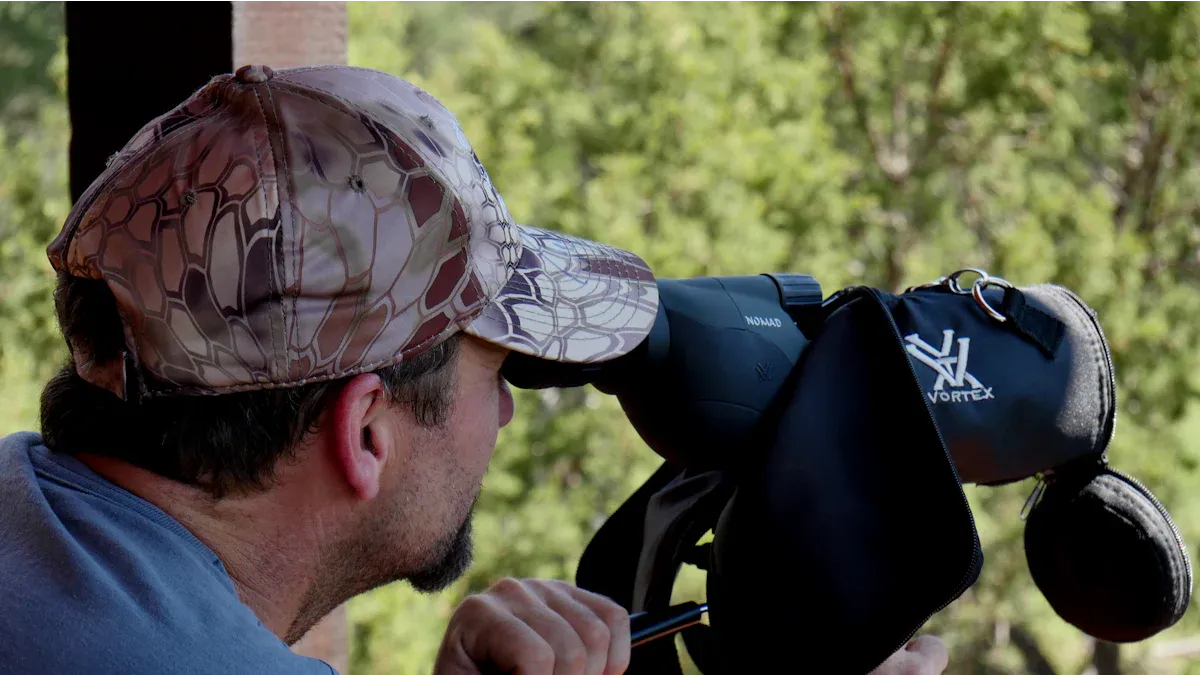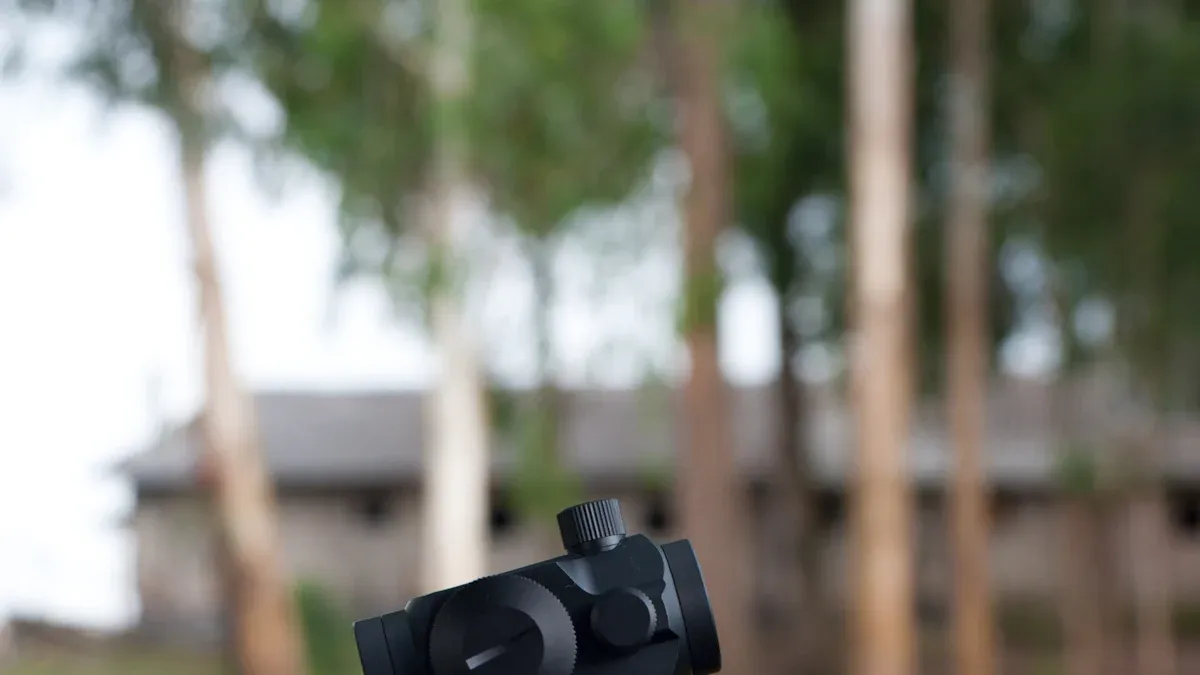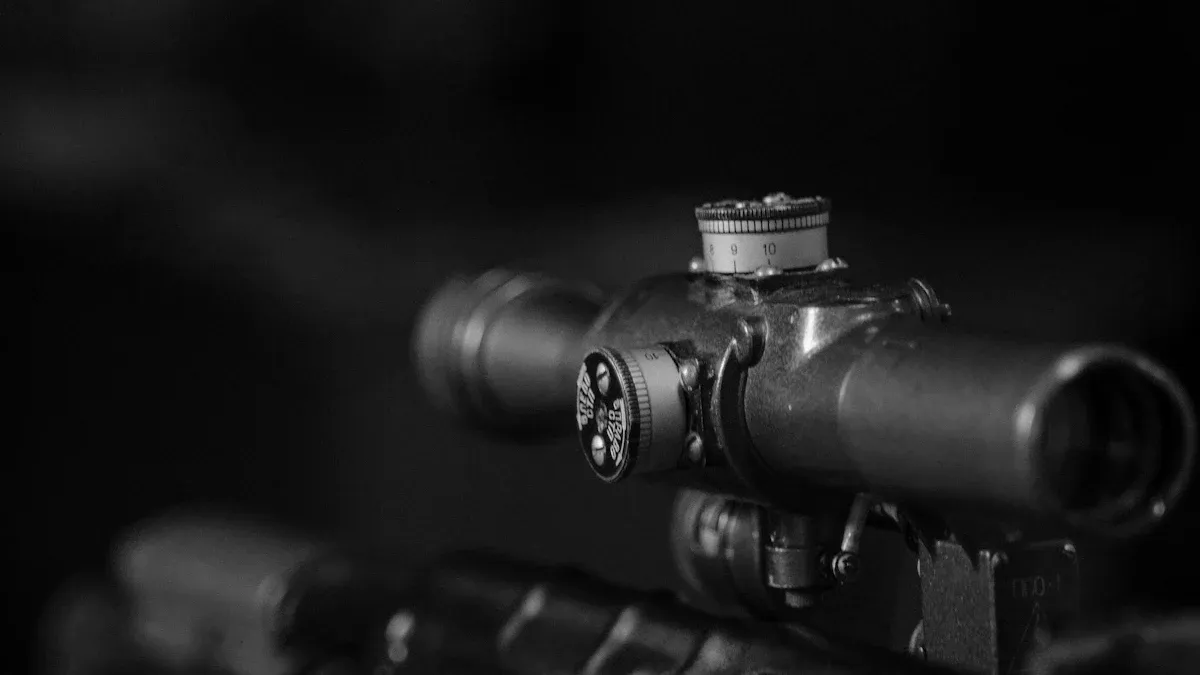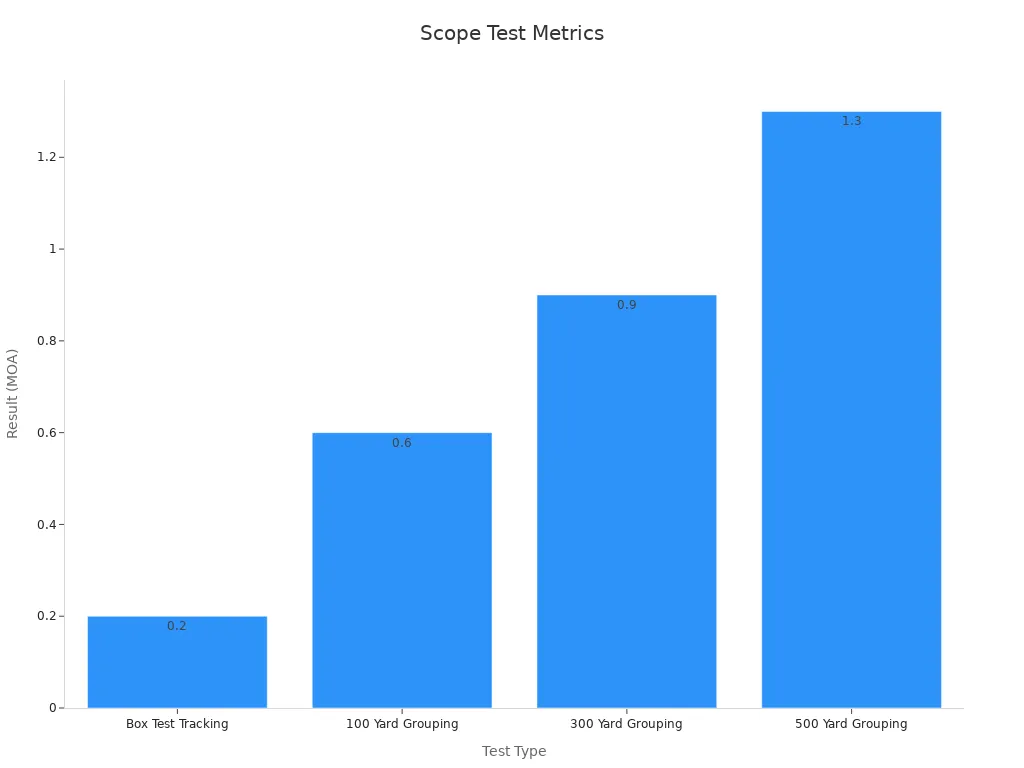
A scope’s focal plane determines how its reticle behaves when magnification changes. First focal plane (FFP) scopes scale the reticle with magnification, ensuring accuracy at any zoom level. Second focal plane (SFP) scopes keep the reticle size constant, which simplifies target acquisition at lower power. For precision shooting, the right rifle scope paired with a stable rifle bipod and rail system can significantly impact performance.
Key Takeaways
- First focal plane (FFP) scopes change the reticle size with zoom. This helps with long-range shots and avoids recalculating holdovers.
- Second focal plane (SFP) scopes keep the reticle size the same. They are easier for beginners and great for quick aiming at low zoom.
- Pick a scope based on how you shoot: FFP scopes are great for accuracy, while SFP scopes are simple and cheaper for everyday use.
Understanding Reticle Behavior in Scopes
Reticle behavior in FFP scopes
First focal plane (FFP) scopes offer a unique advantage by scaling the reticle size in proportion to magnification. This ensures that the relationship between the reticle and the target remains consistent, regardless of zoom level. For shooters, this consistency is critical for accurate holdovers and range estimation.
In FFP scopes, the reticle grows or shrinks with magnification adjustments, maintaining predictable performance across all power settings. This feature eliminates the need for recalculating holdover points, making it ideal for long-range shooting scenarios.
Empirical data highlights the importance of reticle selection based on intended usage. FFP reticles excel in applications requiring precise rangefinding and holdover capabilities. However, tracking accuracy and canted reticles can occasionally affect performance. Testing for these issues, such as tolerance stacking, ensures reliability in critical situations.
Reticle behavior in SFP scopes
Second focal plane (SFP) scopes behave differently. The reticle size remains constant, regardless of magnification. While this simplifies aiming at lower power, it introduces challenges at higher magnifications. The perceived separation of reticle points, such as mil dots, changes with zoom levels, potentially affecting aiming precision.
- The reticle’s fixed size can lead to variations in point of impact when using holdover points at different distances.
- Shooters must adjust their calculations based on the magnification setting to maintain accuracy.
- Despite these challenges, SFP scopes are favored for their simplicity and ease of use in hunting or general-purpose shooting.
Understanding these differences helps shooters select the right scope for their needs, ensuring optimal performance in various scenarios.
First Focal Plane (FFP) Scopes

Advantages of FFP scopes
First focal plane scopes offer several advantages that make them a preferred choice for precision shooters. The reticle’s ability to scale with magnification ensures consistent subtension, allowing for accurate holdovers and rangefinding at any zoom level. This feature eliminates the need for recalculating adjustments, saving time in critical situations.
- Reviews based on extensive field testing highlight the effectiveness of FFP scopes in maintaining accuracy across magnifications.
- Experienced long-range shooters and hunters praise their consistent reticle performance, even in challenging conditions.
- The clarity of FFP scope glass rivals high-end brands, enhancing visibility and precision.
The reticle’s constant size in relation to the target simplifies rangefinding. Hunters benefit from this feature during twilight hours when visibility is low, as FFP reticles remain bright and visible even at high magnifications.
Disadvantages of FFP scopes
Despite their benefits, FFP scopes have some drawbacks. The reticle’s scaling can make it appear too small at low magnifications, potentially hindering quick target acquisition. Additionally, FFP scopes are often more expensive than their second focal plane counterparts, which may deter budget-conscious buyers.
- Some users report difficulty in using the reticle at lower power settings due to its reduced size.
- The complexity of FFP scopes may require a steeper learning curve for beginners.
Ideal applications for FFP scopes
FFP scopes excel in scenarios requiring precision and adaptability. Their consistent reticle subtension makes them ideal for long-range shooting, hunting moving targets, and low-light conditions. The table below outlines their suitability for various shooting disciplines:
| Shooting Discipline | Ideal Usage Scenario |
|---|---|
| Long-Range Shooting | Precision shooting at extended distances with accurate adjustments and holdover. |
| Hunting Moving Targets | Quick target acquisition and tracking for big game or fast-moving prey. |
| Low-Light Hunting | Bright and visible reticle for accurate aiming in dimly lit environments. |
| Competitive Shooting | Precision and versatility for fine adjustments in various shooting disciplines. |
FFP scopes provide unmatched versatility, making them a valuable tool for shooters who demand accuracy and reliability in diverse environments.
Second Focal Plane (SFP) Scopes
Advantages of SFP scopes
Second focal plane scopes offer simplicity and reliability, making them a popular choice for many shooters. The reticle remains the same size regardless of magnification, which simplifies aiming and target acquisition. This feature is particularly beneficial for hunters and recreational shooters who often operate at lower magnifications.
- SFP scopes are easier to use for beginners due to their straightforward design.
- They are typically more affordable than first focal plane scopes, making them accessible to a wider audience.
- Recent advancements in SFP technology have enhanced their performance, improving usability across various applications.
The steady demand for SFP scopes reflects their practicality. Their fixed reticle size ensures a clear and consistent aiming point, even when magnification changes. This reliability makes them a trusted tool for general-purpose shooting.
Disadvantages of SFP scopes
Despite their advantages, SFP scopes have limitations that may affect performance in certain scenarios. The reticle calibration is accurate only at one specific magnification setting. This can lead to inaccuracies when using holdover points at other zoom levels.
- The eye box size can be restrictive, which may reduce comfort and usability for some users.
- Proper parallax adjustment is essential, especially at closer ranges. Without it, significant aiming errors can occur.
These limitations highlight the importance of understanding the scope’s design and ensuring it matches the intended application. While SFP scopes excel in simplicity, they may not be ideal for precision shooting at varying distances.
Ideal applications for SFP scopes
SFP scopes are best suited for hunting, recreational shooting, and general-purpose use. Their fixed reticle size and ease of operation make them ideal for scenarios where quick target acquisition is crucial. Hunters benefit from their performance at lower magnifications, especially when tracking moving targets in dense environments.
| Application | Why SFP Scopes Are Ideal |
|---|---|
| Hunting | Simplified aiming and consistent reticle visibility at lower magnifications. |
| Recreational Shooting | Affordable and user-friendly design for casual shooters. |
| General-Purpose Use | Reliable performance for a variety of shooting scenarios. |
SFP scopes provide a balance of affordability, simplicity, and reliability. These qualities make them a versatile choice for shooters who prioritize ease of use over advanced features.
Comparing FFP and SFP Scopes

Key differences between FFP and SFP scopes
First focal plane (FFP) scopes and second focal plane (SFP) scopes differ primarily in how their reticles behave with magnification changes. FFP scopes position the reticle in front of the magnification lens, allowing it to scale proportionally with the target image. This ensures consistent subtensions across all zoom levels, making them ideal for precision shooting. In contrast, SFP scopes place the reticle behind the magnification lens, keeping its size constant regardless of zoom level. While this simplifies aiming at lower magnifications, it can lead to inaccuracies in holdover calculations at higher zoom levels.
- Reticle Subtensions: FFP scopes maintain accurate subtensions at all magnifications, while SFP scopes are calibrated for a specific zoom setting, typically the highest.
- Target Acquisition: SFP scopes excel at lower magnifications, offering a clearer sight picture for faster target acquisition. FFP scopes provide better precision at higher magnifications.
- Cost: FFP scopes are generally more expensive due to their complex construction, whereas SFP scopes are more affordable and widely available.
These differences highlight the importance of selecting a scope based on shooting style and application.
Best scope for hunting
Hunters often prioritize simplicity, durability, and optical clarity. SFP scopes are well-suited for hunting due to their fixed reticle size, which remains easy to see at lower magnifications. This feature aids in quick target acquisition, especially in dense environments. Market research reveals that nearly 60% of hunters value adjustable magnification and clear optics. Additionally, regional preferences show North American hunters favor rugged designs, while European hunters prefer lightweight models.
| Evidence Type | Details |
|---|---|
| Consumer Preferences | Nearly 60% of hunters prioritize optical clarity and adjustable magnification. |
| Regional Preferences | North American hunters favor rugged durability, while European consumers prefer lightweight designs. |
SFP scopes provide the reliability and affordability that hunters need, making them the preferred choice for tracking moving targets in challenging terrains.
Best scope for long-range shooting
Long-range shooting demands precision and adaptability. FFP scopes excel in this domain due to their consistent reticle subtensions across all magnifications. This eliminates the need for recalculating holdover points, ensuring accuracy at varying distances. Performance metrics validate their advantages, including accurate subtensions, consistent reticle spacing, and proportional mil/MOA values.
| Advantage | Explanation |
|---|---|
| Accurate Subtensions | Subtensions remain accurate regardless of magnification, providing consistency for precision shooting. |
| Consistent Reticle Spacing | The reticle lines maintain the same relative distance apart, ensuring accuracy at any zoom level. |
| Consistent Mil/MOA Values | FFP reticles maintain proportional size changes with magnification, ensuring accurate holdover points. |
FFP scopes are versatile and suitable for various shooting disciplines, making them the top choice for long-range enthusiasts.
Best scope for general use
For general-purpose shooting, versatility and ease of use are key. SFP scopes offer a balanced solution with their fixed reticle size and affordability. They perform well across a range of scenarios, from recreational shooting to casual hunting. Consumer data highlights their durability, excellent glass clarity, and versatile magnification range.

| Test | Result |
|---|---|
| Box Test Tracking | 0.2 MOA |
| Reticle Visibility | Excellent |
| Eye Relief | 4.2 in |
| 100 Yard Grouping | 0.6 MOA |
| 300 Yard Grouping | 0.9 MOA |
| 500 Yard Grouping | 1.3 MOA |
SFP scopes provide a reliable and user-friendly option for shooters seeking a versatile tool for everyday use.
Choosing between first focal plane (FFP) and second focal plane (SFP) scopes depends on the shooter’s needs. FFP scopes excel in precision shooting with their scalable reticle, while SFP scopes offer simplicity and affordability.
| Feature | First Focal Plane (FFP) | Second Focal Plane (SFP) |
|---|---|---|
| Reticle Size | Changes with magnification | Remains constant regardless of magnification |
| Ideal Use | Better for fast range changes with BDC patterns | Simpler for general use and target acquisition |
Shooters should evaluate their shooting style, budget, and environment to select the most effective option.
FAQ
What is the main difference between FFP and SFP scopes?
FFP scopes adjust the reticle size with magnification, ensuring consistent subtensions. SFP scopes keep the reticle size constant, simplifying aiming but requiring recalibration for holdovers at different zoom levels.
Are FFP scopes better for long-range shooting?
Yes, FFP scopes excel in long-range shooting. Their scalable reticle ensures accurate holdovers and rangefinding at any magnification, making them ideal for precision shooting over extended distances.
Why are SFP scopes preferred for hunting?
SFP scopes offer simplicity and affordability. Their fixed reticle size aids quick target acquisition, especially at lower magnifications, making them suitable for hunters in dense or fast-paced environments.
Post time: Apr-14-2025
